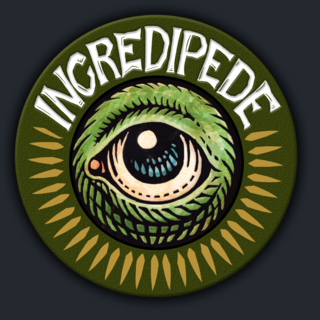INTRO:
Physics-oriented indie games are nothing new by the time of Incredipede. However, games like these but which also happen to have awkward controls are – or rather, were – a bit more refreshing, at least before Bossa Studios chipped away at the novelty of such games (if “novelty” can be used to describe them).
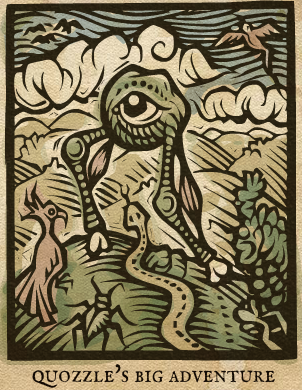
Anyway, during its time circa 2012-2013, Incredipede obtained enough attention to win the status of IGF 2013’s finalist. However, whether it lives up to the hype in the indie scene or not in the eyes of one who is not already an “indie hippie” is another matter.
PREMISE:
There is a story of sorts to Incredipede’s official levels. The protagonist, Quozzle, was a member of a tribe of obviously not-human creatures, whose main bodily feature is a massive cyclopean eye, with limbs jutting out from it.
Her tribe is a peaceful one, residing close to the beach on the continent which they live in. One day, seemingly human privateers have attacked her village and abducted most of her tribe. Quozzle seems to be the only who escaped.
(As for the matter of gender, Quozzle and her tribespeople are described as females. This is not particularly important, however.)
Unfortunately, the story gives an impression that it is there just for the sake of having a story. It does little to explain why the protagonist is a creature which never has a consistent body structure, despite being depicted as vaguely humanoid in the visual illustrations of the story. The story does not provide narrative justification to the other gameplay elements either.
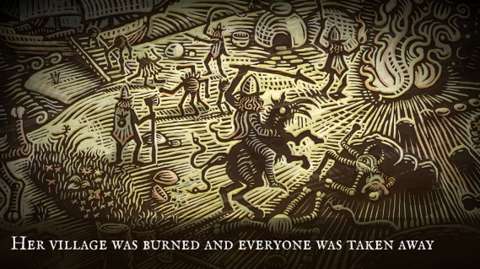
GAMEPLAY – IN GENERAL:
As mentioned already, the gameplay in Incredipede is about solving physics-based puzzles with awkward controls.
This is to put things simply of course. The physics-based puzzles are made a lot more challenging than they look due to the awkward controls. On the other hand, the controls can be as awkward as the player wants, due to a feature to build the locomotion of the player character in whatever way the player deigns.
There are some amusing moments to be had, especially from testing how the player character moves about after creating a monstrosity out of her/it. However, all these are ultimately only there for the gameplay goal of having the player character move from point A to point B while collecting or transporting things along the way. This can seem like a wasted opportunity for more sophistication in the game.
TUTORIALS:
Regardless of which mode (“normal” or “hard”) the player chose when starting a play session, he/she will be given tutorials on gameplay elements whenever they are first introduced in the official levels. The “normal” mode does appear to have more gradual tutorials though, so the new player might want to start with “normal” first.
For the most part, the instructions in the tutorials are sparse; it is up to the player to figure out what to with what has been learned.
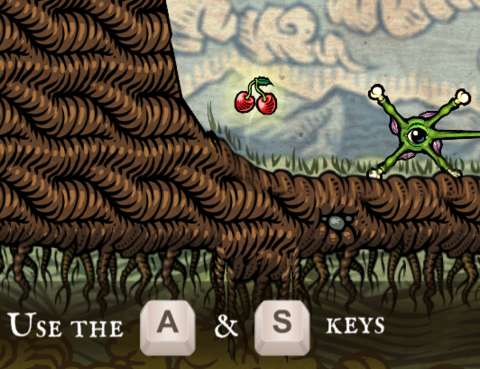
PROGRESS IN OFFICIAL LEVELS:
To reach the resolution of what passes as the story in Incredipede, the player must attempt the official levels and “collect” knick-knacks, in addition to completing them.
These levels are categorized according to what are called in-game as “worlds”, for whatever reason. (Perhaps this is a reference to certain Nintendo games, but if so, they are rather weak references.)
To get to the next “world”, the player must gather specific numbers of collectibles, which are specified at the bottom of the screen. Ostensibly, this is the toll which must be paid to the gatekeeper of the next “world”.
Experienced players might have encountered such a system before; it has been around in other puzzle games too, as a way to give the player some freedom to pick which levels to play while preventing the player from simply jumping forward too far. Some players may consider this progress-controlling system to be antiquated though (this reviewer included).
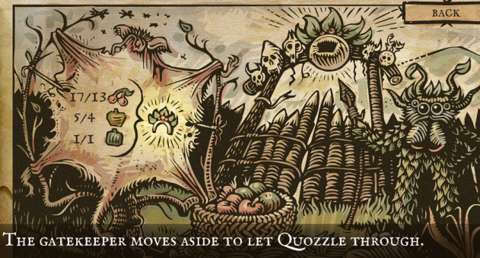
GOAL OF EACH LEVEL:
The gist of each level is to move Quozzle towards a goal-post of sorts; the goal-post is depicted with a glowing pillar of light. Crossing the pillar of light at any point completes the level, “rewarding” the player with what passes as Quozzle’s expression of satisfaction.
This is easier said than done, of course. As mentioned earlier, Quozzle is a creature with an inconsistent bodily structure, with each structure having a different way of moving from the other structures.
Furthermore, the player has to strive to retrieve any “collectible” in the level, if only to progress in the official levels. Again, this is easier said than done.
CONTROLS & MUSCLES:
The most entertaining aspect of this otherwise mundane game is the controls for the player character. The player character has body parts which have what the game calls “muscles”.
These muscles provide locomotion to the body parts, such as rotating it. Each set of muscles connects two “limbs” together; one of the limbs moves relative to the other. (Players with knowledge of kinematics may understand this statement; as for other players, they are probably better off not playing the game.)
The player may only rotate a muscled limb clockwise or anti-clockwise. This can result in the player character seemingly dragging itself/herself about, often in an awkward manner.
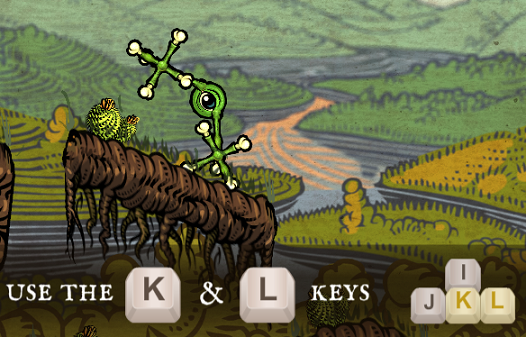
There is a gameplay feature of setting limbs and muscles which will be described later.
“COLLECTIBLES”:
In every official level, and any user level if its creator deigned it fit, there are trinkets to be collected.
These trinkets may take the form of fruits, flowery decorations and such other things which the artist for the game conjured. However, they can be simply categorized into three types.
The first is a trinket which just floats in the air, waiting for the player character to pick it up. This one is completely unaffected by physics, and the challenge which they pose is getting the unwieldy player character to them.
The second is a trinket which is affected by physics, especially gravity. For example, in some official levels, they already start off falling or rolling down slopes. More often than not, the player must attempt to “catch” them, which is easier said than done considering that the player character is often not built to do so.
The third is a trinket which is larger than the previous two. Otherwise, it is a lot like the second trinket.
The nuance about the second and third trinket types is that they cannot be collected by the player character; this is a rarity in puzzle-oriented video games, in which collectibles are generally retrieved on the spot.
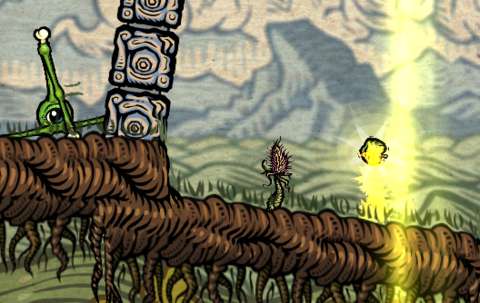
Rather, the player needs to somehow transport or otherwise move these trinkets over to the pillars of light. Yet again, this is easier said than done.
GOAL-POSTS:
As mentioned earlier, the goal-posts are depicted as pillars of light in the levels. It is the player’s prerogative to get the player character past it.
Specifically, the player only needs to get the torso/eye of the player character past the goal-post. This is made clear through one of the official levels which occurs early on.
HAZARDS & OBSTACLES:
A physics-based puzzle game would not be one without some things to bar or otherwise complicate the player’s progress. Overcoming these can be far more difficult than overcoming similar obstacles in other games, due to the awkward controls; even a bump can turn the player character topsy-turvy if the player is not careful.
There are also more hazards and obstacles beyond mere uneven terrain.
WATER:
Water appear in some levels, usually surrounded by other terrain. Quozzle cannot drown, strange creature that she/it is, but she/it can barely swim either; in some official levels, Quozzle has a body which is so bizarre that she/it is pretty much stuck in the water if she/it falls into it.
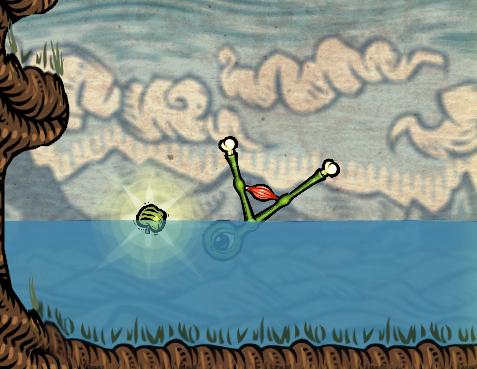
However, Quozzle is generally quite buoyant; she/it shoots up quite fast when submerged. The assumption that muscles do not float does not hold water here either (pun intended). Adding to her mass with more limbs and muscles does complicate her upwards floatation, however; the inertia from all those limbs can be tricky.
FALLING:
Despite the lands which Quozzle lives in being portrayed as being obviously a continent, the levels which she/it has to go through consist of platforms which seemingly float in the sky. This means that Quozzle is very much at risk of falling off the level, clumsy and ungainly as she/it is.
LAVA:
It seems that most physics-oriented puzzle games just cannot break away from the trope of lava hazards.
Anyway, for whatever reason, the lands which Quozzle lives in appear to have lava pits – which float in the air together with other floating things too, sometimes seemingly upside-down. Quozzle can be immobilized and killed if she/it happens to fall in lava. Fortunately, Quozzle happens to float on lava too, so the player still has a chance of getting her out.
If any part of Quozzle gets into lava, it is not burnt off immediately. Instead, it appears to heat up, changing from Quozzle’s ‘natural’ green to alarming shades of red, before disappearing altogether; any adjoining muscle is also removed. This can potentially render entire limbs useless, if the limb which has been burnt off is in between other limbs.
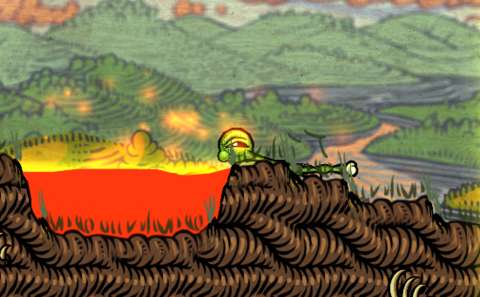
If the part being burnt off is Quozzle’s eye, the player has to restart the level. There is simply no salvaging this mishap.
MOVABLE OBJECTS:
Shortly after having introduced trinkets which can move about, Incredipede introduces other movable objects which act more like hindrances and/or primitive tools instead of collectibles.
The first of these are rocks. Getting hit by rocks does not appear to injure Quozzle in any way; rather, the player might want to worry more about having to move around or over them. As mentioned earlier, the controls are already so awkward; having to use them to get around rocks will be quite the ordeal, and that is not exactly an overstatement. Moreover, to make use of the rocks, the player must have adequate understanding of traction – and how to attain traction with an oddly-limbed freak.
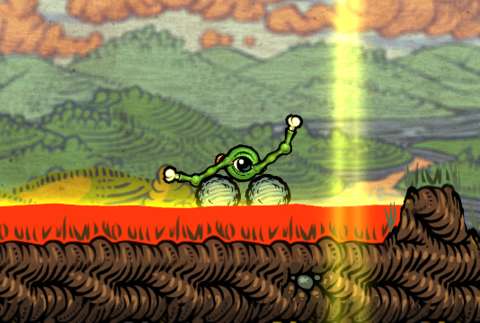
There are two kinds of rocks: square and circular. The circular ones are a lot easier to move around, though conversely also more difficult to keep in place.
GRAVITY:
Gravity apparently only applies to collectibles, rocks and the player character. It is not applied on terrain, including water and lava, which just stay where they are, even if pools of them are upside-down. This can cause quite some disbelief. (A screenshot which appears later shows an example.)
WINDS:
The gameplay element of winds is introduced in “World 3”. For whatever reason, Quozzle can be blown up into the air by winds, even if she/it is just an eyeball with bony limbs.
Anyway, the direction of the winds are depicted by dry leaves being blown into the air too. Using this as a guide, the player can reorient Quozzle’s limbs so as to catch as much of the wind as possible or narrow it down so that the winds do not blow her/it around too much.
It can take a while to learn how to make use of the wind (especially if the player still cannot get over the disbelief), but there are a few introductory levels in “Normal” mode to help the player practice.
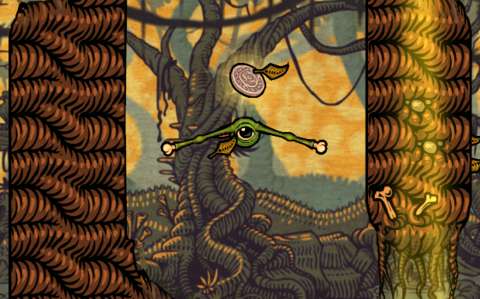
“HARD” MODE:
The “Hard” mode of the game is intended to present the gameplay element of “building” Quozzle’s limbs and muscles; this will be described later.
However, for the sake of players who simply jump into the “Hard” mode from the get-go, the first “world” in this mode act as a set of tutorials for movement and learning about the physics in this game, in addition to tutorials for building Quozzle.
Incidentally, many of the levels in “Hard” mode are variations of the ones in “Normal” mode, which is perhaps to be expected.
Since most of the levels in “Hard” mode are variations of the ones in “Normal” mode, the player who has played the “Normal” mode is better positioned to learn about adding muscles and limbs to Quozzle’s torso-eye.
The “Hard” mode progresses in such a manner that the gameplay elements about muscles and limbs which have already been described in this review will be taught to the player in easy lessons. However, the player has to play the levels in sequence in order to learn these lessons in a coherent manner.
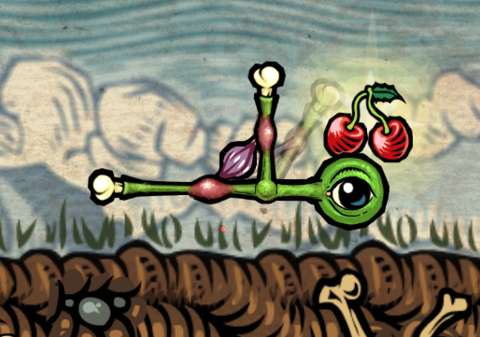
Skipping levels even if there is freedom to do so is generally not a good idea unless the player is already experienced in the game.
CREATURE-“BUILDING”:
If the player plays the “Hard” mode of the game, he/she gets to build Quozzle’s parts, sometimes from scratch or from an incomplete ‘template’. Most of the controls for doing so have context-based visual indicators, such as those which show the locations where the player can link muscles to.
The player can generally add as many muscles and limbs as he/she wants – if he/she can control the resulting abomination. The game does not seem to grade the player on how many limbs or muscles have been used to solve a puzzle with, though it does record that information anyway, likely to help players compare their performances with each other’s or their own.
ADDING LIMBS & MUSCLES:
Adding limbs and muscles is a lot easier than the resulting arrangements would suggest. As long as the player gives himself/herself enough space to do so and examine them, he/she can create a functional Quozzle.
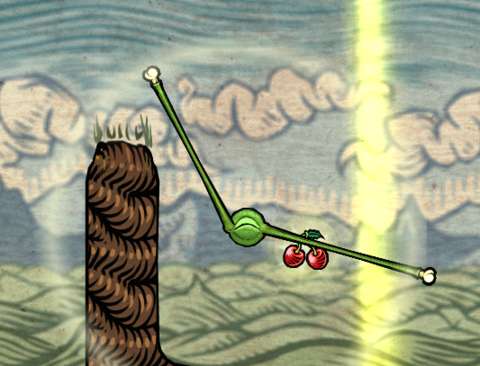
There are limitations though. For one, limbs can only be stretched so far; there is also a limit to the total length of a sequence of limbs, e.g. if one limb has taken half of this total, the adjoining limbs can only have the remaining half for the purpose of being stretched.
Muscles can only be added by linking them from one limb to the previous limb. This also means that the first set of limbs which the player sprouted out from Quozzle’s torso-eye can only have muscles attached from them to the torso-eye.
These limitations can be a bit disappointing, if the player is looking forward to creating a massive and incredibly awkward monstrosity. On the other hand, there is no limit to the number of limbs or articulations, so the player can still create very complex multi-pod creatures.
QUICK-RESET BUTTON:
The developer of Incredipede has realized that the game might be a bit frustrating for some players. Therefore, there is the convenience of simply resetting the level with the tap of a button, specifically the Spacebar.
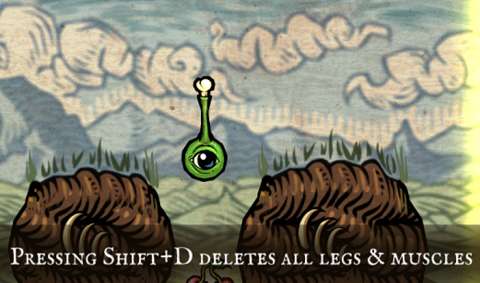
LEVEL & CREATURE EDITOR:
Usually, one can argue that including a level editor in a game is additional value. That is technically always true – but whether this is actually worthwhile or not is debatable, depending on the sophistication of the level editor.
In the case of Incredipede’s, it could be disappointing to players who have seen far more sophisticated editors. It is reminiscent of an object-based IDE, such as its use of stretchable terrain which brings to mind the stretchable form objects in Visual Studio.
At least the level editor does the satisfactory minimum; any gameplay element which has been mentioned thus far is there to be implemented when designing a level with the level editor.
Alternatively, the player can choose to just save his/her design of Quozzle, if he/she is more interested in creating freaks of nature of instead of bizarre environments.
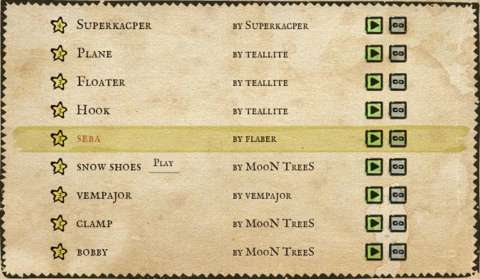
VISUAL DESIGNS:
Much of the artwork of Incredipede has been provided by Thomas Shahan, a talented woodblock artist whom the game’s creators met while they were travelling.
As the creator of the game has written in the credits for the game, Shahan’s artwork is rather striking, especially that for terrain and Quozzle’s body parts. It is rare that there are artists who can create artwork with high contrast without resorting to bright colours as in psychedelic games or deep-dark blotches in moodier ones.
Unfortunately, there are some ugly contrasts. This can be seen in the ‘artwork’ for lava and water, which are bland in comparison with Shahan’s artwork. One could guess that this is the work of the game’s creators, and not Shahan’s.
Every character is vaguely humanoid. This is of course not an issue during gameplay: Quozzle is likely to be far from humanoid-looking when the player gets to control her/it anyway. Speaking of controlling Quozzle, the muscles in her/its body clearly undulates as Quozzle moves about, which is a slightly unsettling but amusing touch.
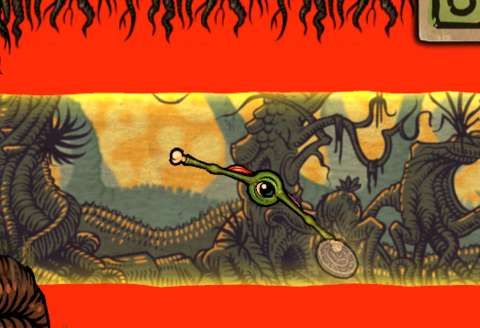
Quozzle is a sentient creature which does have feelings. However, being composed of just an eye and gangly limbs, there is not much which the artist can do in order to have Quozzle express her/its emotions. The most which had been done is Quozzle’s eye closing and opening as a person’s would in tense situations.
SOUND DESIGNS:
Jordan Fehr, which made some of the sound effects for Super Meatboy, made some of the sound effects for this game too. There is not that much to listen to though; there are thuds for when Quozzle or other things hit the ground and for when stuff falls into lava, but there are no sound effects associated with water and almost nothing for winds.
As for the music, the tracks are pleasant and quite matching with the settings for the game. However, they are not original tracks; rather, they are royalty-free soundtracks. At the very least, the choice of tracks do show that one of the game’s creators has a good ear for thematically matching music.
MINOR COMPLAINT:
There is something odd about one of the designs for the menus in the game. This is about the “Go Back” button.
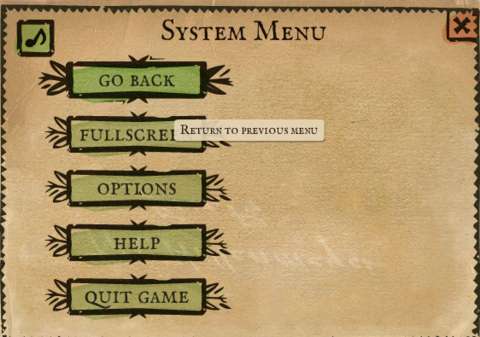
In other games, the player might expect this button to close the current menu and return the player to the current game instance. It does not in Incredipede. Instead, it brings the player back to the previous screen; in the case of actual game sessions, it returns the player to the level selection screen.
This can be annoying for a while, until the player learns to simply click on the “X” button.
CONCLUSION:
Incredipede offers amusement from wrangling with the awkward controls which result from the game’s feature of creature creation. Yet, this source of amusement is short-lived; Incredipede is also not the only game around which offers such amusement. Furthermore, these gameplay elements are mere features in a gameplay experience which has been seen in other physics-based puzzle games.
There is the pleasant artwork, but it is contrasted by some visual blandness; the same can also be said about the sound designs, most of which are not original anyway. There is the level editor, but with the gameplay already as simple as it is, there is not that much longevity which can be eked from it.
There is not much of anything refreshingly new which Incredipede can offer.
